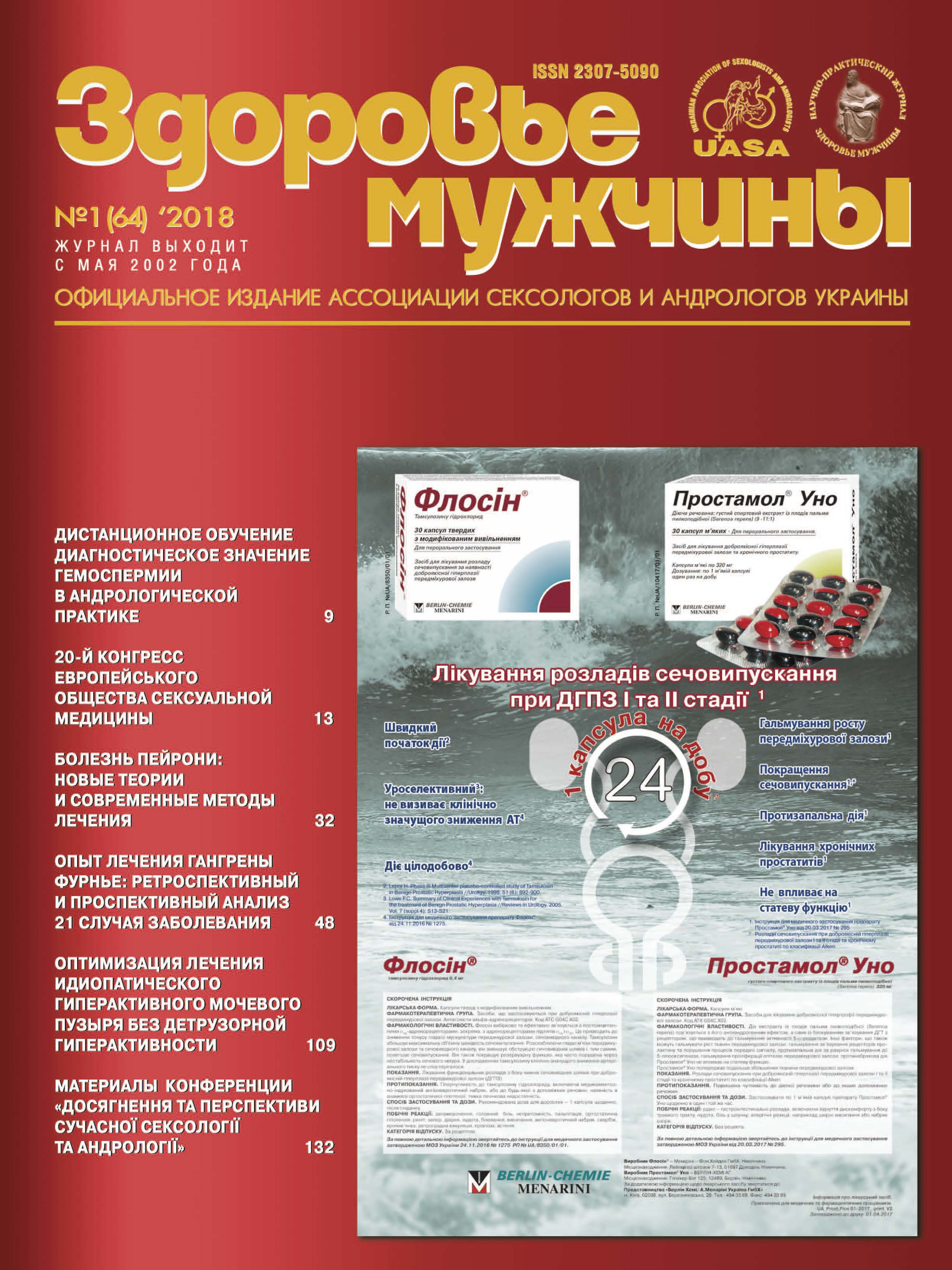Development and validation of a questionnaire for recurrent urinary tract infection RUTIQ
##plugins.themes.bootstrap3.article.main##
Abstract
The objective: development and validation of a questionnaire for diagnosis, detailing and population assessment of clinical and laboratory symptoms and assessing the quality of life of patients with recurrent UTI RUTIQ (Reccurent Urinary Tract Infection Questionnaire).
Materials and methods. To assess the sensitivity of the questionnaire to changes, depending on the severity of clinical changes and the total score, the questionnaires were divided into two groups. Based on the results of testing, the first group included patients with an initially high score of the questionnaire and, accordingly, more pronounced clinical manifestations. The second group included patients with a relapse of the urinary tract infection, indicating moderate changes in the physical and psychoemotional state, with moderate clinical manifestations of the disease. Patients received standard therapy and 10 days after the initial questionnaire completed the questionnaire again. A survey of the validation of the RUTIQ questionnaire was completed by 49 respondents. The age of the patients ranged from 21 to 77 years, the average age was 37.2 ± 3.7 years. The average duration of the disease is 6.1 ± 1.1 years.
Results. The results of this study confirm the high psychometric properties of the domains of the questionnaire, their accessibility and informativeness, questions and answers to patients are clear and understandable. Positive and reliable correlations between the obtained test results and comparator questionnaires, UTISA and SF-36, satisfactory sensitivity to changes suggest that RUTIQ domains can statistically reliably reflect the course of the disease, social functioning and changes in the quality of life related to health.
The conclusion. The application of the questionnaire allows to significantly optimize the primary and repeated diagnostic tactics in patients of the target group, to study in detail the features of the history of the disease, the details of the medical history, the details of the nature of the transferred therapeutic and diagnostic activities with a high level of reliability.##plugins.themes.bootstrap3.article.details##

This work is licensed under a Creative Commons Attribution 4.0 International License.
Authors retain the copyright and grant the journal the first publication of original scientific articles under the Creative Commons Attribution 4.0 International License, which allows others to distribute work with acknowledgment of authorship and first publication in this journal.
References
Stamey TA: Pathogenesis and Treatment of Urinary Tract Infections. Baltimore: Williams & Wilkins, 1980.
Nicolle L. Epidemiology of urinary tract infections. Infect Med 2001. https://doi.org/10.1016/S0196-4399(02)80035-6
Segal AJ, Amis ES, Jr, Bigongiari LR, et al. Recurrent lower urinary tract infections in women. American College of Radiology. ACR Appropriateness Criteria. Radiology. 2000;215:671–6.
Ellis AK, Verma S. Quality of life in women with urinary tract infections: is benign disease a misnomer? J Am Board Fam Pract 2000; 13: 392–7. https://doi.org/10.3122/15572625-13-6-392
Baerheim A., Digranes A., Jureen R. et al. Generalized symptoms in adult women with acute uncomplicated lower urinary tract infection: an observational study. MedGenMed. 2003;5(3):1.
The EuroQol group. EuroQol – a new facility for the measurement of health related quality of life. Health Policy 1990. https://doi.org/10.1016/0168-8510(90)90421-9
Epidemiology of urinary tract infections: incidence, morbidity, and economic costs. Dis Mon 2003. https://doi.org/10.1067/mda.2003.7
Hooton TM, Scholes D, Hughes JP et al.A prospective study of risk factors for symptomatic urinary tract infection in young women. N Engl J Med 1996; 335: 468–74. https://doi.org/10.1056/NEJM199608153350703
Colgan R, Keating K, Dougouih M. Survey of symptom burden in women with uncomplicated urinary tract infections. Clin Drug Invest 2004; 24: 55–60. https://doi.org/10.2165/00044011-200424010-00007
Foxman B, Frerichs RR. Epidemiology of urinary tract infection. https://doi.org/10.2105/AJPH.75.11.1308 https://www.doi.org/10.2105/AJPH.75.11.1314
Foxman B, Barlow R, D’Arcy H, Gillespie B, Sobel JD. Urinary tract infection: self-reported incidence and associated costs. Ann Epidemiol 2000; 10: 509–15. https://doi.org/10.1016/S1047-2797(00)00072-7
Wild D., Grove A., Martin M. et al. Principles of Good Practice for the Translation and Cultural Adaptation Process for Patient-Reported Outcomes (PRO) Measures: report of the ISPOR Task Force for Translation and Cultural Adaptation. Value Health.2005;8(2):94–104. https://doi.org/10.1111/j.1524-4733.2005.04054.x
Cronbach L.J. Test «reliability» its meaning and determination. Psychometrika. 1947;12(1):1–16. https://doi.org/10.1007/BF02289289
Ware JE Jr, Sherbourne CD. The MOS 36-item Short-Form Health Survey (SF-36). I. Conceptual framework and item selection Med Care 1992; 30: 473–83. http://dx.doi.org/10.1097/00005650-199206000-00002
Kelleher CJ, Cardoza LD, Khullar V,Salvatore S. A new questionnaire to assess the quality of life of urinary incontinent women. Br J Obs Gynecol 1997; 104:1374–9. https://doi.org/10.1111/j.1471-0528.1997.tb11006.x
Morris A., Perez D., McNoe B. The use of quality of life data in clinical practice // Qual.Life Research. – 1988. – Vol. 7. – Р. 85–91. https://www.doi.org/10.1023/A:1008893007068
Cronbach L.J. Coefficient alpha and the internal structure of tests // Psychometrica. – 1951. – Vol. 16, № 3. – Р. 297–334. https://doi.org/10.1007/BF02310555
Quality of life and pharmacoeconomics in clinical trials / Ed. Spiker B. 2nd Edititon. – Philadelphia: New-York Lippincott-Raven, 1966. – 1259 p.
Quality of life assessment in clinical trials / Ed. M.J. Staquet. – Oxford University Press: Oxford, New York, Tokyo, 1988. – 360 p.
Quality of life assessment in clinical trials / Ed. B. Spiker. – New York, 1990. – 24 p.
Ware J.E. and Sherbourne C.D. The MOS 36-Item Short Form Health Survey (SF-36). I. Conceptual framework and item selection. Medical Care, 1992, V.30, 473–483. http://dx.doi.org/10.1097/00005650-199206000-00002
Clayson D., Wild D., Doll H., et al. Validation of a patient-administered questionnaire to measure the severity and bothersomeness of lower urinary tract symptoms in uncomplicated urinary tract infection (UTI): the UTI Symptom Assessment questionnaire. BJU Int.2005;96(3):350–359. https://doi.org/10.1111/j.1464-410X.2005.05630.x





